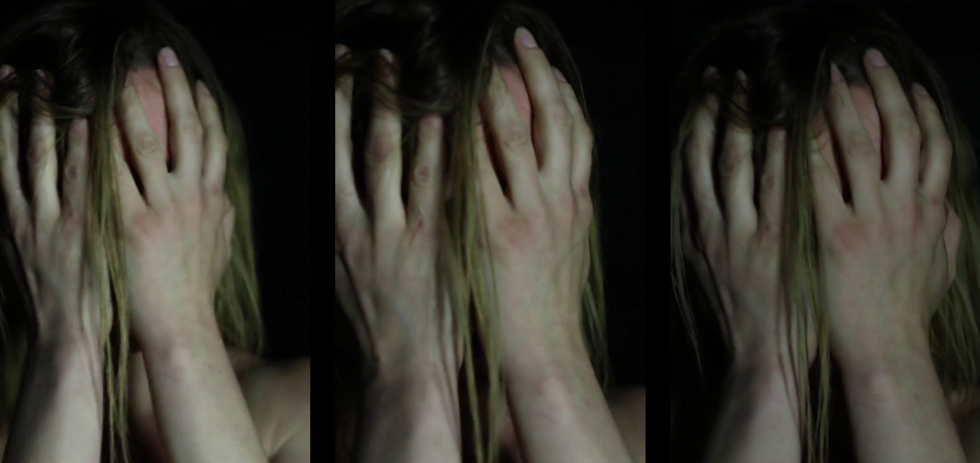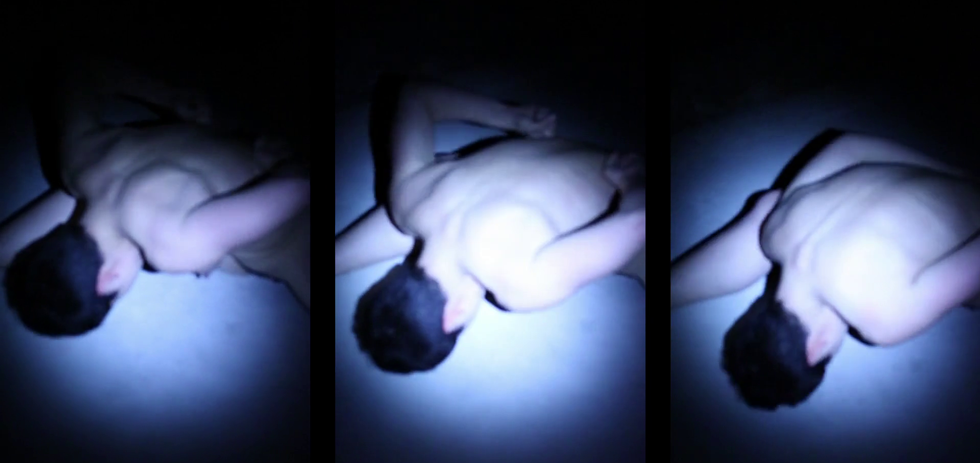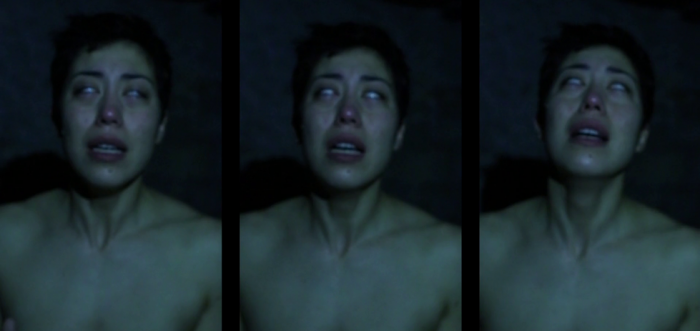On Saturday 28 September 2019, protesters gathered in Harcourt Road by the Central Government Complex of Hong Kong to mark the five-year anniversary of the Umbrella Movement, a series of pro-democracy demonstrations that brought the city to a standstill for 79 days in 2014. The occasion, unsurprisingly given events in Hong Kong over the last six months, was like an echo in time from the events they were commemorating, the demonstrators greeted by tear gas and water cannons, as were those who came before them. Meanwhile, on the other side of Hong Kong Island in Empty Gallery, located at the edge of Aberdeen Harbour, less than 10 kms south of these protests, a new, multi-screen video installation by French artist and filmmaker Philippe Grandrieux was being opened. The exhibition, entitled The Bare Life, fills the gallery space with, on the lower level, three video works that together form Grandrieux’s Unrest trilogy and, on the upper level, a new eleven-screen installation called The Scream.
In many respects, these two events, taking place simultaneously and in close proximity to each other, could not be further removed from each other. Grandrieux’s exhibition was commissioned long before the current protests had started up and his work in general (with some exceptions) avoids explicit political engagement or commentary, never more so perhaps than in these new works. Grandrieux’s feature length fiction films (Sombre (1998), A New Life (2002), Un lac (2008), Despite the Night (2015)) are all associated with what James Quandt has named the “New French Extremity”, also referred to by critic Tim Palmer as “cinema of the body”, these terms referring to films by a group of directors that seek to engage the viewer on an affective level, depicting bodies in extreme situations, both sexual and violent, pushing at the bounds of what can be represented on screen and also, particularly in the work of Grandrieux, of narrative logic. A similar approach is found even in Grandrieux’s documentary work, Return to Sarajevo (1996) and It May Be That Beauty Has Strengthened Our Resolve – Masao Adachi (2011), which, in spite of their politically-loaded subject matter, are concerned primarily with capturing the interactions of bodies with each other and the space around them. This same methodology is taken to its furthest extreme in the works on display in Hong Kong, all of which are produced out of an intense collaborative process involving Grandrieux and a number of dancers that produces studies of bodies in motion, almost entirely abstracted from any narrative, historical or geopolitical context. And yet, somehow, these works resonate forcefully with the current events (born of a very particular constellation of historical and geopolitical contexts) in the Special Administrative Region where they are on display and help us to understand why, in times like these, we need art more than ever.
To claim that Grandrieux’s work is apolitical may seem a little strange given the title of this exhibition that references work by Italian political philosopher Giorgio Agamben. For Agamben, the concept of “bare life” arises in extreme political situations when a state of exception becomes the rule. In such situations – examples of which include the concentration camps in World War II or Guantánamo Bay – the juridico-political frameworks that would normally govern the actions of the ruling powers no longer apply, with the result that human beings perceived to be a threat to that power can be stripped of their human rights and of any agency, reduced to a form of “bare life” that exists outside of the social, moral, ethical and judicial frameworks that both empower and protect us.
While it is easy to see how the loss of human rights at the heart of Agamben’s concept resonates strongly with the fears that are currently fuelling the Hong Kong protests, for Grandrieux this concept is deployed somewhat differently. For him, Agamben’s term is used as a means to conceptualise a primordial form of life that connects us back to a pre-social mode of being, to a way of being in the world governed not by social mores and societal norms but, rather, by sensation, by a direct, embodied link to the world around us – such as when a newborn infant, blinded by a rush of visual stimuli screams in reaction to and as a means to connect with its new environment and breathe. And perhaps there is in fact something implicitly political in this attempt to create a different relation to the world, for in bypassing understanding and privileging sensation, work such as this provides us a space to engage with that which cannot be understood.

Grandrieux’s new work The Scream, shown in Empty Gallery for the first time, takes his attempt to figure a pure, instinctual relation to the world that can only be witnessed and not understood to its furthest extreme yet. The spectator is presented with a series of vignettes, each of which reveals a solitary, naked female figure in a dark cave or cellar-like space. These bodies scream, laugh, hum, sing, pant, breathe, pulse, heave, thrash, flail, tremble, convulse, kick, grunt, groan, strain, wrack, hyperventilate, spasm, shake, rub, slap, slide, hit, strain, contort, stretch, claw, rock, twitch, whisper, scream, scream, scream, scream.
The work has some obvious cultural reference points, as noted by Michel Rubin: Edvard Munch, Antonin Artaud and the contorted figures in the paintings of Francis Bacon, his screaming popes in particular. And yet here, now, in their current context, how could they not also recall the daily stream of images broadcast from Hong Kong of bodies being beaten, hit, shot, teargassed, thrown to the ground, shackled and battered, of people shouting, crying, protesting, weeping and screaming?
Quite by chance, the very form of Grandrieux’s work reinforces this link, for just as our Twitter feeds are filled with a parade of images and videos of many different events of the same kind shot from a seemingly infinite number of different perspectives, so Grandrieux’s new work repeats the same images across eleven screens (each 2m x 1.12m and presented in a vertical aspect ratio) with a two-second delay between each. The effect is somewhat like that of a canon, a piece of music in which different voices or instruments play the same music starting at different times. And like a canon, especially but not only when Grandrieux’s performers sing or hum, what results is a conflation of identities as the harmonic relations between individual voices conjoin them according to a higher order and make it hard to locate any single voice.
If Grandrieux’s work can then speak to us of the many instances of brutality currently being witnessed in Hong Kong, at those moments when harmonic relations are established across the work’s polyphonic form, it seems almost to ventriloquise the “million scream” movement that started in Hong Kong on August 19, 2019. In an echo of a famous scene from Sidney Lumet’s 1976 film Network, the “million scream” is a happening that takes place at 10pm each night as Hong Kong protesters shout out slogans from their windows, attaining an anonymous form of solidarity as their voices echo each other in the dark.
There is an important difference, however, for in Grandrieux’s work it is not different voices that echo each other but the same voice, the same body. The effect of this is deeply unsettling as the individual subject we see is stripped of their uniqueness, replicated in a potentially infinite series of different times. While this might be thought of as yet another way in which Grandrieux’s work resonates with the situation of those individual citizens in Hong Kong who risk losing their identity and shout out their HK Identity Card number as they are arrested by police in the hope of safeguarding their very life, it is important to remember that Grandrieux’s work is not about the situation in Hong Kong. What the replicant logic of his work does exemplify is the ability of art to help us think through our own situation, even when it comes from and speaks of a very different time and place.

This idea, of course, is nothing new and has been commonplace since Barthes declared the author to be dead, this being the most famous denunciation of what was called in twentieth-century literary criticism the “intentional fallacy,” a reductive interpretive framework that aimed to establish authorial intent and thus to constrain the potential of the work of art to its own context. This ability of the work of art to transcend its own time and place, however, has perhaps never been more important than at the present moment, because in spite of the formal similarity noted here between Grandrieux’s work and the stream of repeated images filling our social media feeds, the temporality governing these formats could not be more different. Indeed, if the work of art is able to transcend its own time, the 24-hour news cycle of our contemporary mediasphere is resolutely situated in its own fleeting, evanescent present; a recent article in The Conversation suggests that the world is turning away from the situation in Hong Kong because “the things that made the protests initially so captivating was their novelty and bravery. But what began as original is now predictable”. While the article goes on to suggest ways in which the Hong Kong protests might learn some lesson from the French Revolution about how to re-engage the public, I would argue that it is deeply troubling that the media streams through which events such as this come to us have the potential to render atrocity banal via overexposure, to bore us with their endless feed of yet more violent acts rather than engage us ever more.
This, then, is why in times like these we need work like Grandrieux’s more than ever, because it explicitly rejects this kind of relation with the image, carving out an aesthetic that counters the anesthetic effect of the mediasphere, awakening our senses and abnegating the possibility of sublimation. Here then there is a great deal of violence, as Artaud understood well when he argued, in his Manifesto for a Theatre of Cruelty, for an aesthetic act that would grab us by the throat to wake us up to the true baseness of our world. In a phrase that resonates forcefully with the evanescent superficiality generated by the clickbait hyperspeeds of our contemporary moment, Artaud writes, in The Theatre and Its Double: “Our long habit of seeking diversion has made us forget the idea of a serious theater, which, overturning all our preconceptions, inspires us with the fiery magnetism of its images and acts upon us like a spiritual therapeutics whose touch can never been forgotten” (84-5). Once again: this, then, is why in times like these we need work like this more than ever, for this is a violence intended not to suppress but quite the opposite. This is violence as a necessary site of care, a gesture of love, that enables us to intuit a different relation to time and forces us to confront our universal humanity, to understand our connection to each other across space and time. Artistic forms are not empty vessels designed only to transmit content to us but deliberately crafted to forge a relation with us, to make us feel the paint, love, sorrow, anger, rage, joy, fear, hope, despair and suffering of others as though it were our own and thus to compel us to do something when we see that something demands to be done.
The Bare Life is showing at Empty Gallery until 30 November 2019.
Greg Hainge is Professor of French at the University of Queensland and author of Philippe Grandrieux: Sonic Cinema (Bloomsbury Academic, 2017).
